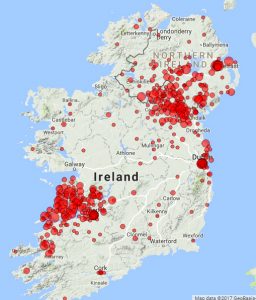Christmas is Ireland is deeply peculiar. By mid-December collective hibernation hysteria has gripped us all and we are compelled to stockpile food as if the world were about to end on Christmas Eve. On that day, we enter the family cave, roll a giant stone across the entrance and wait a solid ten days with only our family and our mounds of decaying food for company. It’s safe to come out again around January 6.

So the annual Christmas hibernation is a good time to get stuck into a nice big project: a giant jigsaw, a marathon game of Risk, knitting a giant woolly jumper … Or mapping all the heads of household in the 1911 census of Ireland.
With data from the National Archives census site, I’ve just plotted the location of all the 3500 strange areas used for the census, District Electoral Divisions (giant jigsaw), counted the number of heads of household of every surname in each DED (marathon game of Risk) and mapped the two onto a Google map (giant woolly jumper). For a sample of what I’ve ended up with, have a look at the Lavins.

The results are useful in a number of ways. Most simply, it is much easier to grasp geographic distributions when they can be visualised and not just read. But there are many other uses – seeing the variant spellings that appear in the census, working out how the traditional homelands have shifted in the half-century since Griffith’s, catching outliers in places you mightn’t expect …
Of course there are caveats.
The way I worked out the locations of the DEDs was by identifying the latitude and longitude of a townland or street in each District, as recorded in the 1901 Townlands Index. This means that any changes between 1901 and 1911 aren’t captured and also that the point chosen on the map could be well away from the District’s centre, especially true for urban areas. And for those urban areas, the NAI transcript’s naming is truly weird. “Clifton”, “Clifton Ward” and “Clifton, Belfast Urban No. 2” are different versions of the same DED in Belfast. “Inn’s Quay”, “Inns Quay” and “Inn’s Quay (part of)” all cover the one Dublin DED. I’ve tried just to reproduce what NAI did, but be warned: at times I was utterly boggled.
There are also problems with the surnames. Over 10,000 heads of household (out of a total of 900,000) have surnames I don’t already have listed. The vast majority are certainly mis-transcriptions, but there also real names in there. George Zuorro, an Italian ice-cream seller in Belfast, is just one. Sorting out the real from the mis-transcripts is a big project in itself.
Maybe over the Easter hibernation.
Having gone through all the records for the Kilkeel area in full, I found the census records to be fairly accurately transcribed, but the GRONI and Ireland genealogy BMD records each had a number of mistranscriptions and typos in the names, which, on top of the phonetic spelling used in many records, makes searching difficult in some cases.
Very cool
Thanks so much for this..but maybe you do need to get out more! Happy New Year and do keep knitting wooly jumpers, we love them!
Thank you John for your great research. I also love your illustrations and your grand wit!
Wish I. Ould find some O’Hara relatives or Keaney in and around Cloonclare, East Barrs, Co. Leitrim.
Ann
What a project. Amazing–thank you. I have just paid for a year’s subscription–overdue since you left the Irish Times, apologies. I must say it is sobering to see the decline in my surnames since Griffith’s. I knew it but to see it so graphically….
Seeing this bit of fun with your relatives – literally – makes my want to adopt you. Mags~
Remarkable work. Many thanks. By coincidence, I am a Lavin descendant and it’s a branch about the Irish origins of which I have no information at all. This is very helpful.
Just curious John. What made you pick the DED rather than the townland?
There are 64000 townlands, plus around 15000 streets, as opposed to about 3000 DEDs. So the mapping would have taken forever. Also resolving that number of points on a Google map would be very bad manners and very slow.
And the aim was to provide an overview, not a substitute for the census site itself.
Good to see you survived 2016, John – keep up the good work! I’ve been linking your site on genealogical groups for years now, the maps in particular very handy.